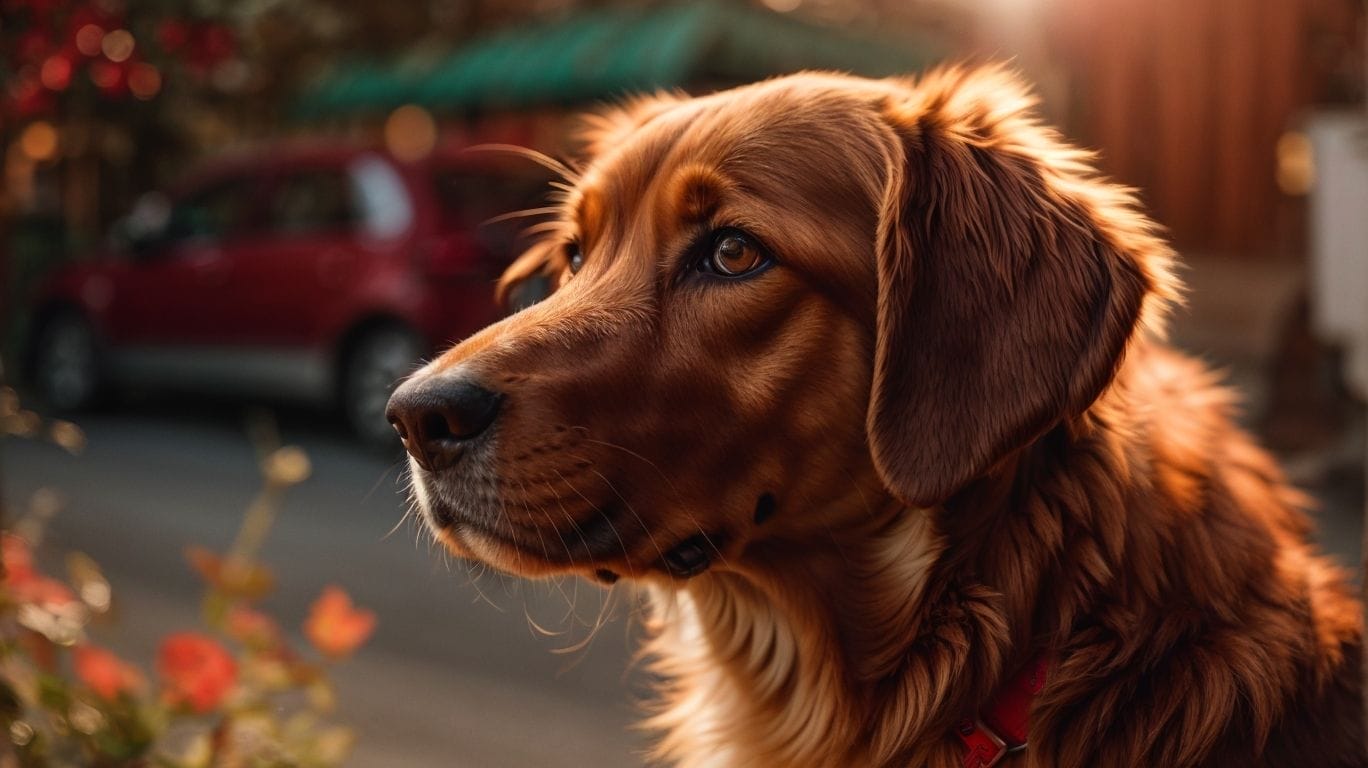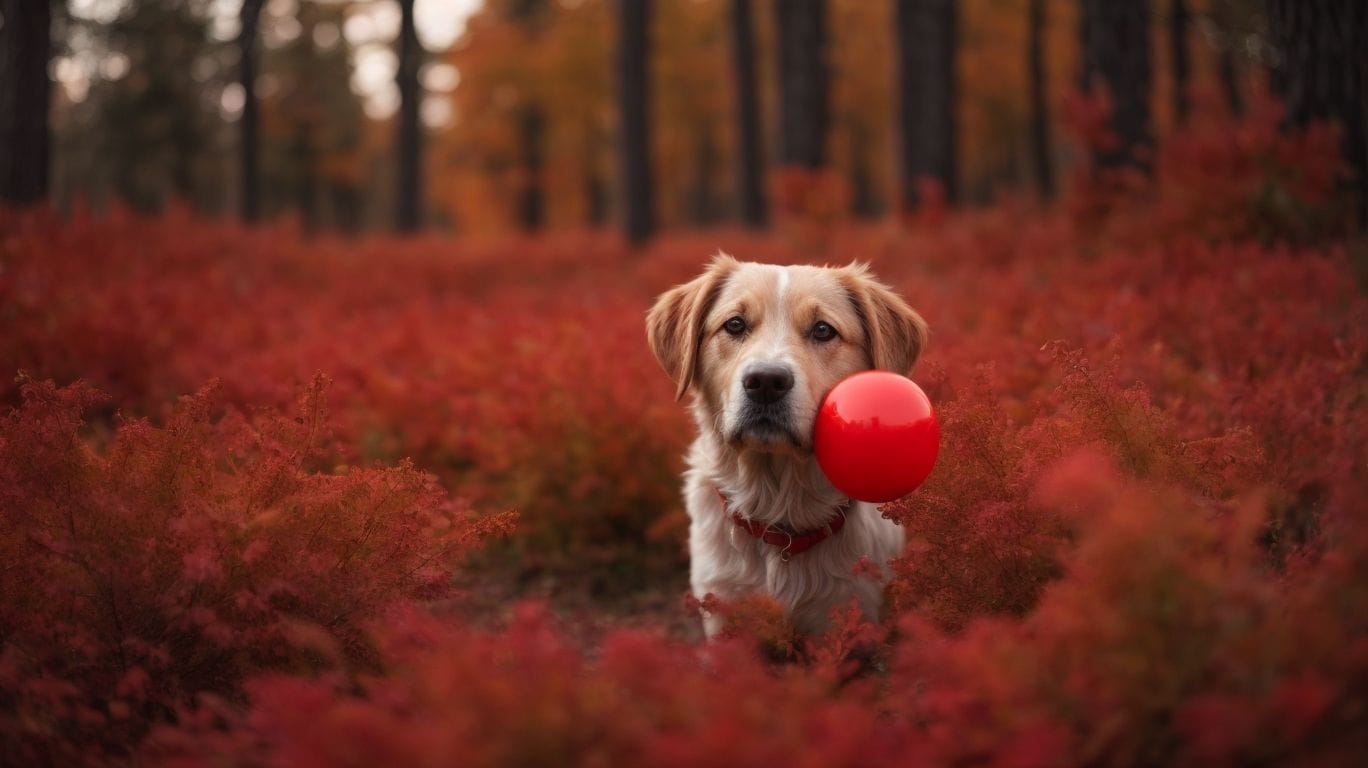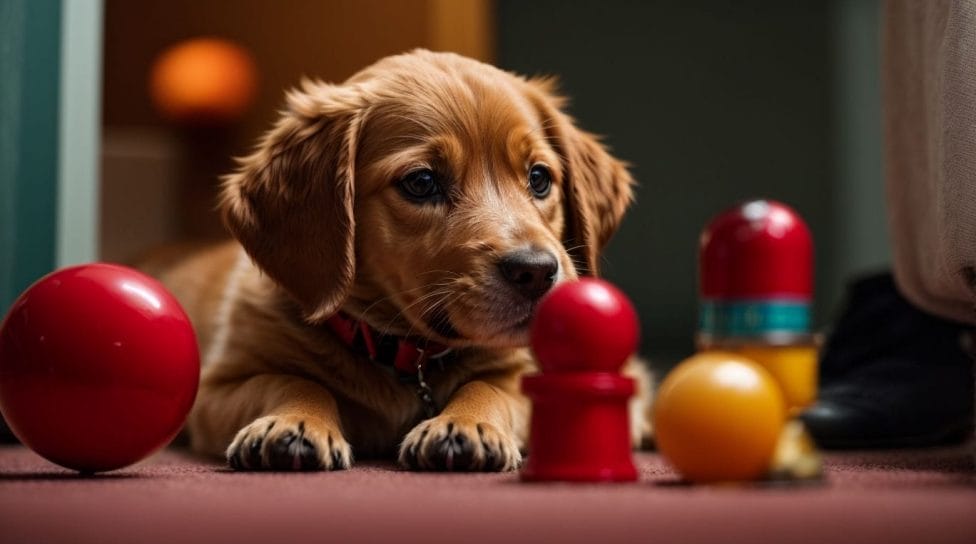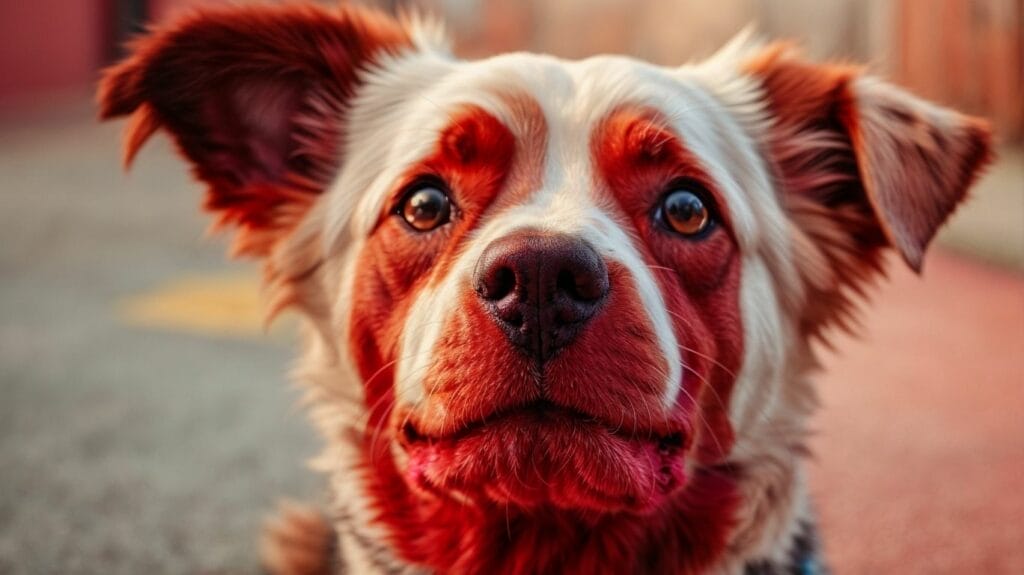Many pet owners have wondered about the extent of their furry companions’ color vision and whether dogs can see red. While humans perceive colors in a range of hues, it is worth exploring how dogs’ visual capabilities differ.
Understanding canine color vision is a fascinating area of study that sheds light on how dogs perceive the world around them. In this article, we will delve into the differences between human and canine color vision, explore the colors that dogs can see, and specifically address the question of whether dogs can see red.
By gaining insights into dogs’ color perception, we can better understand their visual experiences and make informed decisions in areas such as training, behavioral cues, and toy selection.
Key takeaways:
- Dogs have limited perception of red: Unlike humans, dogs have difficulty perceiving the color red due to differences in their visual spectrum. Their vision is more attuned to shades of blue and yellow.
- Challenges in perceiving red for dogs: The cones in a dog’s retina, responsible for perceiving color, are less sensitive to long wavelengths, such as those associated with red. This makes it challenging for dogs to distinguish red objects.
- Implications and considerations: Understanding canine color vision is important for dog training and behavior. Avoiding red toys or using red as a training cue may be less effective, while blue and yellow colors may be more easily distinguishable for dogs.
Can Dogs See Colors?

Photo Credits: Petnarnia.Com by Patrick Campbell
Discover the fascinating world of canine vision as we delve into the question: Can dogs see colors? We’ll explore the difference between human and canine color vision, unlocking the mysteries behind how our furry friends perceive the world around them. Get ready to dive into the canine visual spectrum and gain a new appreciation for the unique ways in which dogs interpret the vibrant hues that surround us.
The Difference Between Human and Canine Color Vision
The difference between human and canine color vision is significant. While humans have three types of color receptors (cones) that enable us to see a wide range of colors, dogs only have two types of cones. This means that dogs see a more limited color spectrum compared to humans.
Dogs primarily see shades of blue and yellow, but they have difficulty distinguishing between red and green. This difference in color perception is important to consider when interacting with dogs and selecting objects for them.
Understanding canine color vision can help improve training methods and ensure that dog toys are appealing to their visual senses.
Understanding the Canine Visual Spectrum
Dogs have a unique visual spectrum that distinguishes them from humans, and dog owners must comprehend this spectrum in order to provide appropriate training and select suitable toys. Dogs possess dichromatic vision, meaning they see a limited range of colors compared to humans. While they can distinguish shades of blue and yellow more effortlessly, they struggle with perceiving red and green. This limited perception of certain colors affects their depth perception and their ability to recognize red toys. By understanding the canine visual spectrum, we can better tailor our interactions and create environments that offer the most enjoyable experience for our furry companions.
Pro-tip: When choosing toys for your dog, opt for colors such as blue and yellow, as they are more easily visible to them.
What Colors Can Dogs See?

Photo Credits: Petnarnia.Com by Arthur Young
Discovering the world of colors through a dog’s eyes is a fascinating exploration. In this section, we’ll dive into the spectrum of colors that dogs can perceive. From their remarkable ability to distinguish shades of blue and yellow to their limited perception of red and green, we’ll unravel the intriguing world of a dog’s color vision. So, let’s unveil the vivid palette that our furry friends experience and understand the impact it has on their perception of the world around them.
Ability to Distinguish Blue and Yellow
The ability of dogs to distinguish between blue and yellow is a fundamental aspect of their color vision. Dogs, unlike humans, who have three cones for perceiving a wide range of colors, only have two cones. This means that their color perception is limited compared to humans.
In the table provided below, you can see the clear distinction that dogs make between blue and yellow:
| Color | Dogs’ Perception |
| Blue | Can perceive |
| Yellow | Can perceive |
| Red | Limited perception |
| Green | Limited perception |
To further emphasize this ability, let’s consider the example of a dog named Max. Max was specifically trained to fetch a yellow ball from a field. However, on one particular occasion, Max accidentally picked up a blue ball instead. This incident serves as a perfect demonstration of dogs’ ability to distinguish between blue and yellow. Max quickly recognized his mistake and promptly went back to retrieve the correct yellow ball.
Limited Perception of Red and Green
Dogs have a limited perception of red and green colors due to their different visual spectrum compared to humans. Their vision is dichromatic, which means they can see shades of blue and yellow but struggle to distinguish between red and green. Studies have shown that the cone cells responsible for perceiving red and green colors in dogs are less sensitive compared to humans. This limited perception of red and green can impact how dogs react to objects of these colors. Understanding dogs’ color vision is important for training and behavior purposes, as well as selecting toys that they can better perceive.
| Color | Perception |
| Blue | Can perceive |
| Yellow | Can perceive |
| Red | Limited perception of red and green |
| Green | Limited perception of red and green |
Do Dogs See Red?

Photo Credits: Petnarnia.Com by Larry Gonzalez
They ever wondered if dogs see red? In this section, we dive into the fascinating topic of dogs’ perception of the color red. Discover the challenges dogs face when perceiving red and explore the intriguing studies and research conducted on how dogs see this vibrant hue. Get ready to uncover the secrets behind our furry friends’ visual world and unravel the mysteries of their perception.
The Challenges of Perceiving Red for Dogs
Dogs face The Challenges of Perceiving Red due to their limited ability to distinguish it from other colors. This is because dogs have a different visual spectrum compared to humans. Studies have shown that dogs have dichromatic vision, meaning they primarily see shades of blue and yellow. The color red appears as a shade of brown or gray to dogs. This can affect their ability to detect red objects or perceive subtle color variations. Understanding these challenges is important for dog owners, trainers, and even when selecting toys for dogs.
I once had a red ball for my dog, but he never seemed interested in it. Curious, I conducted a little experiment by replacing the red ball with a blue one. To my surprise, he suddenly became obsessed with chasing and fetching the blue ball. It was a clear demonstration of the challenges dogs face when perceiving the color red. From that day on, I made sure to choose toys in colors that were easier for my dog to see and enjoy.
Studies and Research on Dogs’ Perception of Red
Studies and research on dogs’ perception of red have shed light on how they perceive this color. Dogs have limited ability to perceive red as they have fewer red-sensitive cones in their eyes compared to humans. One study conducted by researchers at the University of California, Santa Barbara, found that dogs have a reduced sensitivity to red light and instead perceive it as a shade of gray. Another study published in the journal Animal Behaviour showed that dogs responded less to red objects compared to objects of other colors. These findings have important implications for dog training and behavior, as well as considerations for selecting toys for dogs that take into account their color vision.
How Do Dogs React to Red Objects?

Photo Credits: Petnarnia.Com by Michael Hill
Are you curious to know how dogs react to red objects? Delve into the fascinating realm of canine perception as we explore the impact of contrast and movement on their response. Discover the surprising ways in which dogs can be trained and conditioned to react specifically to the color red. Get ready to unravel the mysteries of our furry friends’ visual world and gain insights into their unique reactions to this vibrant hue.
The Impact of Contrast and Movement
The impact of contrast and movement is significant when it comes to dogs’ perception of colors. Dogs have better visual sensitivity to movement and contrast rather than distinct colors. They can easily detect changes in brightness and movement, making them excellent at tracking moving objects. Contrast plays a vital role in their perception, as objects with high contrast against their background are more noticeable to dogs. Understanding this aspect of canine vision can have implications for training and behavior, as well as selecting dog toys that utilize contrast and movement to engage their visual senses.
Training and Conditioning Dogs to Respond to Red
To train and condition dogs to respond to red, follow these steps:
Start with positive reinforcement: Use treats or rewards to associate the color red with something positive.
Introduce red objects gradually: Begin by placing small red objects near the dog during training sessions.
Pair red objects with commands: Associate specific commands with the presence of red objects to create a connection in the dog’s mind.
Increase difficulty: Gradually increase the size of red objects or introduce them in different environments to solidify the dog’s response.
Consistency is key: Maintain a consistent training routine to reinforce the dog’s response to red objects.
Practice recall with red objects: Incorporate red objects into recall training to further reinforce the dog’s association with the color.
Transition to real-life scenarios: Take the training outdoors or in various settings to ensure the dog’s response extends beyond controlled environments.
A Step-by-Step Guide
To train and condition dogs to respond to the color red effectively, it is important to follow these carefully crafted steps. By incorporating positive reinforcement and gradually introducing red objects, you can establish a strong association in the dog’s mind between the color red and positive experiences.
Step 1: Start with positive reinforcement
Utilize treats or rewards to create a positive association with the color red. By rewarding the dog for responding positively to red, you are laying a solid foundation for further training.
Step 2: Introduce red objects gradually
Begin the training process by placing small red objects near the dog during training sessions. This gradual approach allows the dog to become familiar with the presence of red objects in their environment.
Step 3: Pair red objects with commands
Create a connection in the dog’s mind by associating specific commands with the presence of red objects. For example, when the dog sees a red object, you can use a command like “focus on red” to reinforce the association.
Step 4: Increase difficulty
As the dog becomes comfortable with smaller red objects, gradually increase the size of the objects or introduce them to different environments. This helps solidify the dog’s response to red objects under various conditions.
Step 5: Consistency is key
Maintain a consistent training routine to reinforce the dog’s response to red objects. Consistency helps the dog understand that their response to red is always expected, regardless of the situation.
Step 6: Practice recall with red objects
Incorporate red objects into recall training sessions. By associating the color red with the recall command, you further strengthen the dog’s association with the color and their response to it.
Step 7: Transition to real-life scenarios
To ensure that the dog’s response to red extends beyond controlled environments, take the training outdoors or in various settings. This allows the dog to generalize their response to red objects in real-life scenarios.
By following these steps and remaining patient and consistent, you can effectively train and condition dogs to respond to the color red. Remember to always prioritize the dog’s comfort and well-being throughout the training process.
The Importance of Understanding Canine Color Vision

Photo Credits: Petnarnia.Com by Roger Moore
When it comes to understanding our furry companions, canine color vision plays a crucial role. In this section, we’ll uncover why grasping their unique perception of colors is of utmost importance. From its implications on dog training and behavior to the considerations that emerge when selecting the right toys for our four-legged friends, we’re about to dive into a colorful world that promises insights and surprises. So, let’s take a closer look at the wonders of canine color vision and explore how it shapes our interactions with our beloved dogs.
Implications for Dog Training and Behavior
Understanding the implications for dog training and the behavior of canine color vision is crucial.
Dogs have limited perception of red and green colors, which directly affects their ability to distinguish certain objects. This knowledge holds significant importance when designing training programs and selecting toys for dogs. Contrasting colors and movement play a substantial role in how dogs react to objects. By taking into consideration their visual perception, trainers can effectively teach dogs to respond to specific signals and cues. Understanding the limitations of a dog’s color vision helps to prevent frustration and confusion during training sessions. Incorporating this knowledge into dog training strategies can ultimately lead to more successful and efficient training outcomes.
Considerations for Dog Toy Selection
When it comes to selecting dog toys, there are several important considerations to keep in mind. These considerations can help ensure that you choose toys that are safe, engaging, and appropriate for your dog’s needs.
- Safety: Prioritize toys that are durable and free from small parts that could be choking hazards.
- Size and Breed: Consider the size and breed of your dog to choose toys that are suitable for their chewing strength and play preferences.
- Engagement: Look for toys that offer mental and physical stimulation, such as puzzle toys or interactive toys.
- Age and Energy Level: Consider your dog’s age and energy level when selecting toys. Puppies may benefit from teething toys, while high-energy dogs may enjoy toys that encourage active play.
- Material: Select toys made from safe and non-toxic materials, avoiding toys with buttons, bells, or strings that could pose risks.
By considering these considerations for dog toy selection, you can make informed decisions and choose toys that provide your dog with both entertainment and safety.
Some Facts About Can Dogs See Red?
- ✅ Dogs have only two types of cones in their eyes, limiting their ability to see a wide range of colors, including red. (Source: Our Team)
- ✅ Dogs perceive red as a dark brownish gray or black, lacking the vibrant spectrum that humans see. (Source: Our Team)
- ✅ Yellow, orange, and green appear as varying shades of yellow to dogs, while blue stands out the most and is their favorite color. (Source: Our Team)
- ✅ Dogs have a hard time distinguishing between red and green on green grass, but they can easily see a blue toy. (Source: Our Team)
- ✅ Dogs enjoy toys that are blue and yellow the most. (Source: Our Team)


